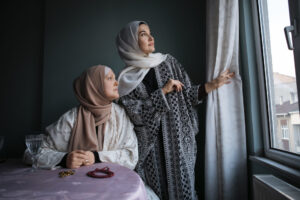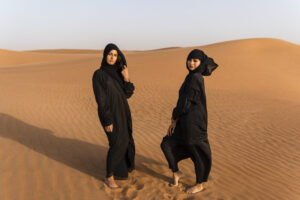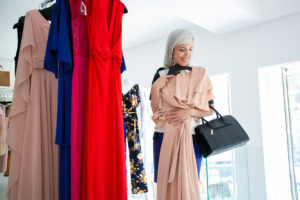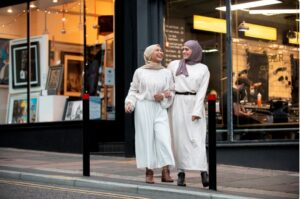
At Stylish Handy Tailors, we are passionate about celebrating the elegance, cultural depth, and versatility of traditional garments like the abaya and jalabiya. These iconic pieces of Middle Eastern attire and Islamic clothing have captivated fashion enthusiasts, cultural scholars, and modest dressers worldwide. Whether you’re a traveler wandering through the vibrant souks of Dubai or Cairo, a fashion lover exploring modest fashion trends, or someone seeking the perfect outfit for a cultural or religious occasion, understanding the difference between abaya and jalabiya is essential.
The abaya and jalabiya share a commitment to modesty and cultural heritage, yet they differ significantly in design, purpose, gender usage, and regional significance. This comprehensive guide, crafted by Stylish Handy Tailors, dives deep into every aspect of these garments, from their historical roots to their modern adaptations. Expect an in-depth exploration of their origins, design nuances, cultural and religious roles, practical uses, styling tips, global influence, and more. Whether you’re curious about abaya jalabiya distinctions or seeking inspiration for your wardrobe, this article is your ultimate resource for traditional Islamic attire.
Historical Origins and Evolution
Origins of the Abaya
The abaya is a long, flowing robe rooted in the Arabian Peninsula, particularly among Bedouin tribes in regions like Saudi Arabia, the UAE, and Qatar. Its origins date back centuries, when it served as a practical garment to shield wearers from the desert’s harsh sun, sand, and wind. Made from lightweight, breathable fabrics, the early abaya was both functional and modest, aligning with the region’s cultural and environmental needs.
The abaya’s evolution is deeply intertwined with Islamic principles of modesty, as outlined in Quranic verses like Surah Al-Ahzab (33:59), which encourages women to cover their bodies for dignity and protection. By the medieval period, the abaya became a symbol of religious and cultural identity in Gulf societies, particularly for women. Its traditional black color signified humility and simplicity, though regional variations emerged over time. For example:
- Saudi Arabia: Plain black abayas with minimal embellishments, reflecting conservative traditions.
- UAE: More ornate designs with embroidery or lace, showcasing a blend of modesty and elegance.
- North Africa: Lighter fabrics and looser fits, adapted to local climates.
The abaya’s journey reflects the interplay of religion, culture, and environment, making it a cornerstone of modest fashion and Islamic dress.
Origins of the Jalabiya
The jalabiya (also spelled jellabiya, galabeya, or djellaba) has a broader historical footprint, originating in North Africa and the Middle East, with possible links to ancient Mesopotamian robes. This ankle-length, loose-fitting garment was initially a unisex piece, worn by farmers, traders, and nomads for its practicality in hot climates. Its origins are particularly strong in Egypt, Sudan, and the Levant, where it was crafted from breathable fabrics like cotton and linen.
The jalabiya’s spread across the Middle East and North Africa was fueled by trade routes and Islamic expansion. By the medieval period, it had become a cultural symbol, worn by both men and women in diverse settings. Regional styles emerged, reflecting local aesthetics:
- Egypt: Vibrant colors and intricate embroidery, often worn for cultural festivals.
- Sudan: Lightweight cotton designs for daily wear, emphasizing comfort.
- Gulf Countries: Luxurious fabrics like silk for festive occasions, with simpler styles for men resembling thobes.
The jalabiya’s unisex appeal and cultural versatility distinguish it from the abaya, making it a beloved piece of traditional Middle Eastern attire.
Comparative Historical Timeline
The abaya and jalabiya share roots in modesty and cultural heritage, but their historical paths diverge:
- Pre-Islamic Era: Jalabiya-like robes were worn in ancient Mesopotamia, while abaya precursors protected desert dwellers.
- Islamic Golden Age (8th-13th centuries): The jalabiya spread through trade routes, gaining prominence in North Africa, while the abaya solidified its role in Gulf societies.
- Colonial Period: The jalabiya adapted to local customs in colonized regions, while the abaya remained a symbol of Gulf identity.
- 20th Century: The abaya became standardized in Saudi Arabia as a modesty garment, while the jalabiya gained festive significance in Egypt and Sudan.
- Modern Era: Both garments embraced global fashion trends, with abayas appearing in international runway shows and jalabiyas gaining popularity in diaspora communities.
This timeline highlights the jalabiya abaya distinction: the abaya’s focus on female modesty in Gulf contexts versus the jalabiya’s unisex, culturally diverse role.
Influence of Trade and Migration
Trade routes like the Silk Road and maritime exchanges facilitated the spread of both garments. The jalabiya’s vibrant designs were influenced by African and Levantine textiles, while the abaya’s simplicity reflected Gulf conservatism. Migration, particularly during the 20th century, introduced these garments to diaspora communities in Europe, North America, and Australia, shaping their modern adaptations.

Design and Appearance
Abaya Design
The abaya is characterized by its long, loose-fitting silhouette, designed to cover the body from shoulders to ankles. As an outer garment, it prioritizes modesty by concealing the body’s contours, often worn over regular clothing. Key design features include:
- Fit: Loose and flowing, ensuring complete coverage.
- Sleeves: Long, with flared or fitted cuffs for elegance.
- Neckline: High or hooded for additional modesty.
- Fabrics: Lightweight materials like chiffon, crepe, georgette, or nida, ideal for hot climates.
- Colors and Embellishments: Traditionally black, modern abayas feature colors like navy, beige, or pastels, with embellishments such as embroidery, sequins, lace, or Swarovski crystals.
Modern abaya styles include:
- Open-Front Abayas: Cardigan-like designs, popular in the UAE for versatility.
- Closed-Front Abayas: Fully enclosed, common in Saudi Arabia for conservative settings.
- Kimono Abayas: Wide sleeves and modern cuts, inspired by Japanese aesthetics.
- Dubai-Style Abayas: Luxurious designs with gold embroidery or crystal embellishments.
At Stylish Handy Tailors, our abaya collection blends tradition with innovation, offering options for daily wear, professional settings, and festive occasions.
Jalabiya Design
The jalabiya is an ankle-length, loose-fitting robe with a relaxed silhouette, often featuring a hood or collar. Its unisex design makes it suitable for both men and women, with variations reflecting regional aesthetics. Key features include:
- Fit: Loose and comfortable, less structured than the abaya.
- Sleeves: Wide or straight, often with decorative cuffs.
- Neckline: Varies from high collars to V-necks or hooded designs.
- Fabrics: Cotton, linen, or silk, chosen for breathability and comfort.
- Colors and Patterns: Bold colors (red, green, blue) and patterns like stripes, geometric designs, or embroidery.
Regional variations include:
- Egyptian Jalabiya: Brightly colored with intricate embroidery, ideal for cultural festivals.
- Gulf Jalabiya: Subdued for men (similar to thobes), luxurious for women with silk or satin.
- Sudanese Jalabiya: Lightweight cotton with vibrant patterns for daily wear.
Our jalabiya collection at Stylish Handy Tailors celebrates this diversity, offering designs for casual, festive, and religious occasions.
Comparative Design Analysis
The abaya and jalabiya share a long, loose silhouette, but their differences are pronounced:
- Gender: Abayas are exclusively for women, while jalabiyas are unisex, with male versions resembling thobes or dishdashas.
- Purpose: Abayas prioritize modesty for public wear, while jalabiyas balance cultural expression and comfort.
- Color and Style: Abayas favor muted tones and elegant embellishments, while jalabiyas embrace vibrant colors and patterns.
- Structure: Abayas are structured for full coverage, while jalabiyas have a relaxed, flowing fit.
For example, a wedding abaya might feature delicate lace, while a festive jalabiya could sport bold geometric patterns. These distinctions cater to different aesthetic and functional needs.
Fabric Innovations and Sustainability
Modern abaya jalabiya designs incorporate sustainable fabrics like organic cotton, bamboo, or recycled polyester, reflecting global trends in eco-conscious fashion. At Stylish Handy Tailors, we prioritize sustainable materials, ensuring our garments are both stylish and environmentally friendly.

Cultural and Religious Significance
Abaya’s Cultural and Religious Role
The abaya embodies Islamic modesty principles, symbolizing dignity and privacy for women in Gulf countries like Saudi Arabia, the UAE, and Qatar. Women often pair it with a hijab or niqab, embracing cultural expectations of modesty in public spaces. The abaya’s black color historically signified humility, though modern variations allow for personal expression through colors and designs.
Culturally, the abaya is a marker of identity and elegance. In Saudi Arabia, it’s ubiquitous in public settings, from malls to workplaces. In the UAE, abayas are celebrated as fashion statements, with designers showcasing them in global events. The abaya’s role extends to religious occasions like Ramadan, Eid, or Hajj, where it ensures compliance with Islamic dress codes.
Jalabiya’s Cultural and Religious Role
The jalabiya holds a broader cultural significance, worn by both men and women across North Africa and the Middle East. In Egypt, it’s a symbol of heritage, worn during festivals like Eid or family gatherings. In Sudan, jalabiyas are everyday attire, reflecting simplicity and practicality. For religious contexts like Salah, men wear plain jalabiyas, while women opt for embroidered designs for festive occasions.
The jalabiya’s unisex nature bridges gender divides, celebrating regional diversity. Its vibrant designs reflect the cultural vibrancy of communities in Egypt, Sudan, and the Levant, often paired with traditional accessories like headscarves or belts.
Comparative Cultural Analysis
The jalabiya abaya comparison reveals distinct roles:
- Gender Focus: Abayas are female-focused, tied to Islamic modesty, while jalabiyas are unisex, reflecting cultural inclusivity.
- Context: Abayas are worn in public to adhere to modesty standards, while jalabiyas are versatile for home, casual, or festive settings.
- Regional Influence: Abayas dominate in Gulf countries, while jalabiyas are prominent in North Africa and parts of the Middle East.
Both garments preserve cultural and religious values, making them cherished pieces of traditional Islamic attire.
Symbolism in Modern Contexts
In contemporary settings, the abaya symbolizes empowerment, allowing women to express modesty and style simultaneously. The jalabiya, meanwhile, represents cultural pride, connecting wearers to their heritage. Both garments have become platforms for self-expression, blending tradition with modernity.

Practical Use and Occasions
When to Wear an Abaya
The abaya is designed for public wear, offering modesty and elegance in various settings:
- Daily Wear: In Gulf countries, women wear abayas for shopping, work, or social visits, layering them over casual or professional outfits.
- Religious Events: Abayas are ideal for Ramadan, Eid, or mosque visits, ensuring compliance with Islamic dress codes.
- Formal Occasions: Embellished abayas are popular for weddings or formal gatherings, paired with luxurious accessories.
At Stylish Handy Tailors, our abayas are crafted for versatility, with lightweight fabrics for daily comfort and ornate designs for special events.
When to Wear a Jalabiya
The jalabiya is a multi-purpose garment, suitable for:
- Casual Wear: Its relaxed fit makes it ideal for home wear or informal outings, especially in hot climates.
- Festive Occasions: Embroidered jalabiyas are worn for Eid, weddings, or cultural festivals, with vibrant designs adding flair.
- Men’s Wear: Male jalabiyas, similar to thobes, are worn for daily activities, religious prayers, or social events.
Our jalabiya collection at Stylish Handy Tailors includes options for men and women, from simple cotton designs to luxurious silk pieces.
Comparative Practicality
The abaya and jalabiya differ in practicality:
- Modesty: Abayas ensure maximum coverage for public settings, while jalabiyas offer a relaxed fit for casual or festive use.
- Ease of Wear: Abayas often feature front openings (buttons or zippers), while jalabiyas are pull-on garments, ideal for home wear.
- Climate Adaptability: Both use breathable fabrics, but jalabiyas prioritize lightweight materials like cotton for daily comfort.
Seasonal Adaptations
Both garments adapt to seasonal needs:
- Summer: Lightweight chiffon abayas and cotton jalabiyas keep wearers cool.
- Winter: Heavier fabrics like wool or layered designs provide warmth, especially in North African jalabiyas with hoods.
Modern Adaptations and Fashion Trends
Modern Abaya Trends
The abaya has evolved into a global fashion phenomenon, blending tradition with contemporary style. Key trends include:
- Colorful Abayas: Beyond black, designers offer navy, beige, emerald, and pastel shades.
- Embellished Designs: Sequins, embroidery, and lace add glamour, making abayas suitable for high-fashion events.
- Innovative Cuts: Kimono-style abayas, asymmetrical hems, and layered designs appeal to younger audiences.
At Stylish Handy Tailors, our abaya collection reflects these trends, with designs showcased in fashion hubs like Dubai and London. Designers like Dolce & Gabbana have embraced abayas, highlighting their global appeal.
Modern Jalabiya Trends
The jalabiya has also embraced modernity:
- Vibrant Patterns: Geometric prints and bold colors make jalabiyas stand out for festive occasions.
- Luxury Fabrics: Silk and satin jalabiyas are popular for weddings and celebrations.
- Contemporary Cuts: Slimmer fits and modern silhouettes appeal to younger wearers.
Our jalabiya designs at Stylish Handy Tailors cater to both traditionalists and trendsetters, offering vibrant options for cultural events.
Comparative Fashion Evolution
The abaya jalabiya fashion trajectories differ:
- Global Reach: Abayas have a stronger presence in international fashion, appearing in runway shows and Western markets.
- Cultural Focus: Jalabiyas remain rooted in regional traditions, with a niche appeal in diaspora communities.
- Innovation: Abayas prioritize elegance and modesty, while jalabiyas embrace bold, expressive designs.
Influence of Social Media
Social media platforms like Instagram and TikTok have amplified the popularity of both garments. Influencers showcase abaya styles and jalabiya designs, inspiring global audiences to experiment with modest fashion trends. Stylish Handy Tailors leverages these platforms to share styling tips and new collections.

Styling Tips and Accessories
Styling an Abaya
Style an abaya requires balancing modesty with personal flair:
- Hijab Pairing: Match a plain abaya with a patterned hijab or vice versa for contrast.
- Jewelry: Statement necklaces or earrings add elegance to embellished abayas.
- Footwear: Heels or embellished sandals elevate formal abayas, while flats suit casual looks.
- Layering: Pair open-front abayas with chic dresses or trousers for a modern twist.
Styling a Jalabiya
The jalabiya offers versatile styling options:
- Women’s Styling: Pair with a belt to cinch the waist or add a headscarf for traditional charm.
- Men’s Styling: Combine with a cap or scarf for cultural events, or keep it simple for daily wear.
- Accessories: Gold jewelry or embroidered clutches enhance festive jalabiyas.
Comparative Styling Guide
Abayas are ideal for formal, public settings, while jalabiyas shine in casual or festive contexts. Non-Muslims can wear both respectfully by understanding their cultural significance and choosing appropriate settings.
Cultural Sensitivity in Styling
When styling abaya and jalabiya, respect cultural and religious contexts. For example, avoid overly revealing accessories with abayas in conservative settings, and choose modest jalabiya designs for religious occasions.
Global Influence and Accessibility
Abaya’s Global Reach
The abaya has transcended its regional roots, becoming a global symbol of modest fashion. It’s worn by Muslim women in Western countries and adopted by non-Muslims for its elegance. Controversies, like France’s 2023 abaya ban in schools, highlight cultural tensions. Online retailers like Stylish Handy Tailors make abayas accessible worldwide, offering diverse styles for global customers.
Jalabiya’s Global Reach
The jalabiya has a niche presence, particularly in North African and Middle Eastern diaspora communities. Its vibrant designs appeal to those seeking cultural clothing for festivals or casual wear. Online platforms have increased its accessibility, though it remains less mainstream than the abaya.
Comparative Global Impact
The abaya’s fashion-forward evolution gives it a broader global footprint, while the jalabiya’s cultural significance keeps it rooted in specific communities. Both are now available through e-commerce, making them accessible to a global audience.
Role of E-Commerce
Online platforms have revolutionized access to abaya jalabiya designs. Stylish Handy Tailors offers a curated selection, with detailed size guides and customization options to cater to diverse preferences.
Care and Maintenance
Caring for an Abaya
Proper care extends the life of an abaya:
- Washing: Hand-wash delicate fabrics like chiffon or dry-clean embellished designs.
- Storage: Hang in a breathable garment bag to prevent wrinkles.
- Ironing: Use low heat to avoid damaging delicate embellishments.
Caring for a Jalabiya
Jalabiyas require similar care:
- Washing: Machine-wash cotton jalabiyas on a gentle cycle; dry-clean silk designs.
- Storage: Fold or hang to maintain shape.
- Ironing: Medium heat for cotton, low for silk.
Comparative Care Tips
Both garments benefit from gentle care, but abayas with intricate embellishments require extra caution, while jalabiyas’ simpler designs are easier to maintain.

Future Trends in Abaya and Jalabiya Design
Emerging Abaya Trends
Future abaya designs may include:
- Smart Fabrics: Temperature-regulating materials for enhanced comfort.
- Minimalist Aesthetics: Clean lines and neutral tones for versatile wear.
- Sustainable Practices: Increased use of eco-friendly fabrics.
Emerging Jalabiya Trends
Jalabiya trends may focus on:
- Fusion Designs: Blending traditional patterns with modern cuts.
- Athleisure Influence: Comfort-focused designs for casual wear.
- Cultural Collaborations: Designs inspired by global textile traditions.
Comparative Future Outlook
The abaya’s global fashion influence will likely grow, while the jalabiya may see increased niche appeal as cultural heritage gains attention. Stylish Handy Tailors is committed to staying ahead of these trends, offering innovative designs for modern wearers.
Conclusion
The abaya and jalabiya are more than garments—they’re expressions of culture, modesty, and identity. The abaya, with its female-focused, modesty-driven design, shines in public settings, while the unisex jalabiya celebrates cultural vibrancy in casual and festive contexts. At Stylish Handy Tailors, we’re proud to offer both, crafted with care to honor tradition and embrace modernity.
Explore our collections to discover the perfect abaya jalabiya for your style, and share your experiences with these timeless garments. Whether you’re drawn to the abaya’s elegance or the jalabiya’s versatility, modest fashion has something for everyone.
Frequently Asked Questions
-
What is the difference between an abaya and a jalabiya?
The abaya and jalabiya are both traditional garments rooted in Middle Eastern attire and Islamic clothing, but they differ in key ways:
- Gender: The abaya is exclusively for women, designed to ensure modesty by covering the body from shoulders to ankles. The jalabiya is unisex, worn by both men and women, with male versions resembling thobes or dishdashas.
- Purpose: Abayas prioritize modesty for public settings, often worn over regular clothing in Gulf countries like Saudi Arabia and the UAE. Jalabiyas balance cultural expression and comfort, suitable for casual, festive, or religious occasions.
- Design: Abayas typically feature muted colors (traditionally black) with elegant embellishments like embroidery or lace. Jalabiyas embrace vibrant colors and patterns, such as geometric designs or stripes, especially in regions like Egypt and Sudan.
- Structure: Abayas are structured for full coverage, often with front openings, while jalabiyas have a relaxed, pull-on fit.
At Stylish Handy Tailors, our abaya jalabiya collections reflect these distinctions, offering designs for every occasion.
-
Can men wear a jalabiya?
Yes, the jalabiya is a unisex garment, making it suitable for men and women. For men, jalabiyas are often similar to thobes or dishdashas, featuring simple designs in neutral colors like white or beige, ideal for daily wear, religious prayers, or cultural events. In regions like Egypt or the Gulf, men wear jalabiyas for comfort and cultural expression, often paired with accessories like caps or scarves. Stylish Handy Tailors offers a range of men’s jalabiyas, from casual cotton designs to luxurious silk options for festive occasions.
-
Is an abaya only for Muslim women?
While the abaya is rooted in Islamic principles of modesty and is commonly worn by Muslim women in Gulf countries, it is not exclusively for Muslims. Its elegant, flowing design has made it a global symbol of modest fashion, appealing to women of all backgrounds who value style and coverage. Non-Muslims can wear abayas respectfully by understanding their cultural significance and choosing appropriate settings, such as formal events or cultural gatherings. Stylish Handy Tailors offers abayas in various styles, from traditional to modern, to suit diverse preferences.
-
What is the cultural significance of a jalabiya?
The jalabiya holds deep cultural significance across North Africa and the Middle East, symbolizing heritage and identity. In Egypt, it’s worn during festivals like Eid or family gatherings, reflecting cultural pride through vibrant colors and embroidery. In Sudan, jalabiyas are everyday attire, emphasizing simplicity and practicality. For religious occasions like Salah, plain jalabiyas are common, while ornate designs are chosen for celebrations. Its unisex nature makes it a versatile piece of cultural clothing, bridging gender and regional divides. Explore Stylish Handy Tailors’ jalabiya collection to connect with this rich heritage.
-
How do you style an abaya for different occasions?
Styling an abaya depends on the occasion:
- Daily Wear: Pair a simple black or neutral-colored abaya with a patterned hijab and flats for a chic, everyday look, ideal for shopping or work in Gulf countries.
- Religious Events: Choose a closed-front abaya in a solid color with minimal embellishments for modesty during Ramadan or mosque visits.
- Formal Occasions: Opt for an embellished abaya with lace or sequins, paired with heels and statement jewelry, for weddings or formal gatherings.
At Stylish Handy Tailors, our abayas are designed for versatility, offering options to suit casual, professional, and festive settings.
-
What fabrics are used for abayas and jalabiyas?
- Abaya Fabrics: Abayas use lightweight, breathable materials like chiffon, crepe, georgette, or nida for comfort in hot climates. Embellished abayas may incorporate velvet or satin for formal occasions, ensuring elegance and opacity.
- Jalabiya Fabrics: Jalabiyas are typically made from cotton or linen for daily wear, offering breathability. Festive jalabiyas may use silk or satin for a luxurious feel, especially in Gulf or Egyptian designs.
Stylish Handy Tailors prioritizes high-quality, sustainable fabrics to ensure comfort and durability in our abaya and jalabiya collections.
-
Are abayas and jalabiyas worn in the same regions?
While both garments are worn in the Middle East and North Africa, their prominence varies:
- Abayas: Predominantly worn in Gulf countries (Saudi Arabia, UAE, Qatar) as a staple for women’s public attire, emphasizing modesty.
- Jalabiyas: Common in North Africa (Egypt, Sudan) and parts of the Middle East, worn by both men and women for casual, festive, or religious occasions.
The jalabiya abaya overlap occurs in regions like the UAE, where both are popular but serve different purposes. Stylish Handy Tailors offers region-inspired designs to cater to diverse preferences.
-
Can you wear a jalabiya for formal events?
Yes, jalabiyas can be styled for formal events, especially for women. Embroidered or silk jalabiyas with intricate patterns are ideal for weddings, Eid celebrations, or cultural festivals in regions like Egypt or the Gulf. Pair with gold jewelry, a belt to cinch the waist, and elegant sandals for a polished look. For men, a well-tailored jalabiya in a luxurious fabric can also suit formal occasions. Stylish Handy Tailors’ festive jalabiya collection includes designs perfect for such events.
-
How have abayas evolved in modern fashion?
The abaya has transformed from a traditional black robe into a global fashion statement. Modern trends include:
- Color Variations: Beyond black, abayas now feature navy, beige, emerald, and pastel shades.
- Embellishments: Sequins, embroidery, and lace add glamour, making abayas suitable for high-fashion events.
- Innovative Cuts: Kimono-style abayas, asymmetrical hems, and layered designs appeal to younger audiences.
Designers like Dolce & Gabbana have embraced abayas, showcasing them in international runway shows. Stylish Handy Tailors offers fashion-forward abayas that balance tradition and modernity.
-
Where can I buy authentic abayas and jalabiyas?
Authentic abaya and jalabiya designs are available through reputable retailers like Stylish Handy Tailors. Our online store offers a curated selection of abayas and jalabiyas, crafted with high-quality fabrics and inspired by regional traditions. From traditional black abayas to vibrant Egyptian jalabiyas, we provide options for all occasions, with customization and global shipping. Visit our website to explore our modest fashion collections and find the perfect traditional Islamic attire.
